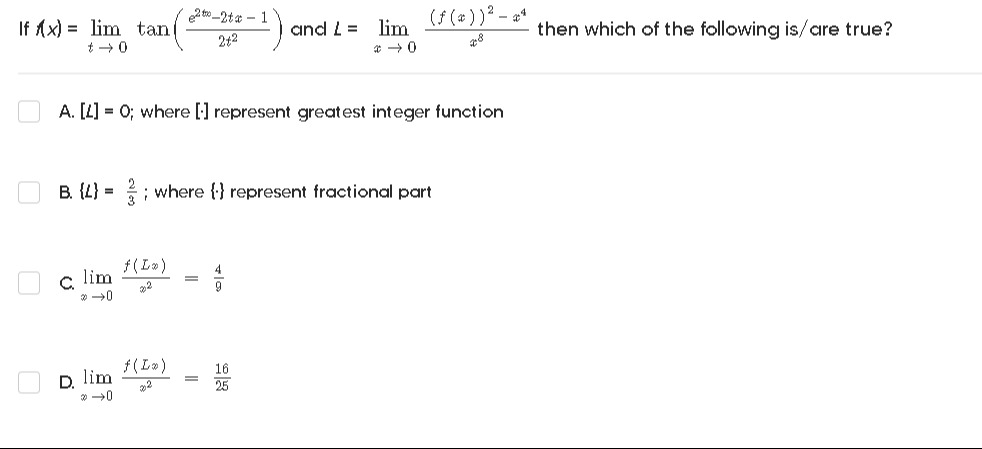Question
Question: If $f(x)=\lim_{t\to 0} \tan\left(\frac{e^{2tx}-2tx-1}{2t^2}\right)$ and $L = \lim_{x\to 0} \frac{(f(...
If f(x)=limt→0tan(2t2e2tx−2tx−1) and L=limx→0x8(f(x))2−x4 then which of the following is/are true?

[L] = 0; where [] represent greatest integer function
{L} = 32; where {} represent fractional part
limx→0x2f(Lx)=94
limx→0x2f(Lx)=2516
Options A, B, C are true.
Solution
Here's how to solve this problem:
1. Find f(x):
f(x)=limt→0tan(2t2e2tx−2tx−1)
Expand e2tx as a series:
e2tx=1+2tx+2!(2tx)2+3!(2tx)3+⋯=1+2tx+2t2x2+34t3x3+⋯
Then,
e2tx−2tx−1=2t2x2+34t3x3+⋯
Dividing by 2t2:
2t2e2tx−2tx−1=x2+32tx3+⋯
As t→0, the higher order terms vanish:
f(x)=tan(x2)
2. Find L:
L=limx→0x8(f(x))2−x4=limx→0x8tan2(x2)−x4
Use the expansion:
tan(x2)=x2+3x6+⋯
Thus,
tan2(x2)=(x2+3x6+⋯)2=x4+32x8+⋯
Therefore,
tan2(x2)−x4=32x8+⋯
Hence,
L=limx→0x832x8=32
3. Check the Options:
Option A:
[L]=[32]=0 (Greatest integer less than 32)
→ True.
Option B:
{L}=L−[L]=32−0=32
→ True.
Option C:
Compute f(Lx):
f(Lx)=tan((Lx)2)=tan(L2x2)=tan((32)2x2)=tan(94x2)
Then,
limx→0x2f(Lx)=limx→0x2tan(94x2)
For small angles, tany≈y:
x2tan(94x2)≈x294x2=94
→ True.
Option D:
States the limit equals 2516, which is not the case.
→ False.
